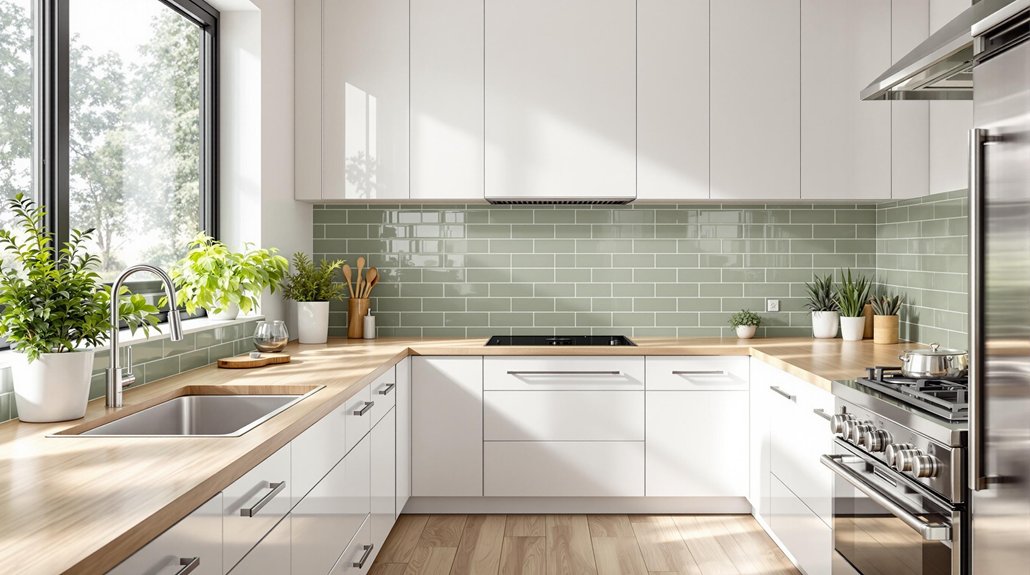
15 Sage Kitchen Backsplash Ideas That Tie the Whole Space Together
Sage kitchen backsplashes achieve unity through materials like classic white subway tile, textured gray herringbone, green-on-green layered tiles, and luxe marble slabs. Playful terrazzo, brass sheet, and quartz options add modernity and warmth, while window or Moroccan tile backsplashes infuse light and artful interest. Choices in finish, pattern direction, and cohesive accents—such as floating shelves or wood details—ensure a visually compelling, practical space. The most inspiring ideas reveal the endless possibilities for sophisticated cohesion.
Key Takeaways
- Classic white subway tiles create a timeless, clean contrast that highlights sage cabinetry and brightens the kitchen.
- Textured gray herringbone tiles add depth and sophistication while balancing the vibrancy of sage green cabinets.
- Green-on-green sage tile backsplashes layer color and texture for a tranquil, cohesive look.
- Luxe marble slab backsplashes introduce elegance and pair beautifully with sage green for a refined palette.
- Playful terrazzo patterns offer customizable color and texture, tying in cabinetry tones for a personalized, cohesive space.
Classic White Subway Tiles for a Fresh Look
A classic white subway tile backsplash delivers a timeless, clean aesthetic that instantly enhances the atmosphere of a sage green kitchen.
These tiles provide a crisp, clean backdrop, allowing sage green cabinetry to stand out while imparting a sense of brightness and spaciousness. The glossy finish of classic white subway tiles reflects ambient light, contributing to an airy environment and reinforcing the kitchen’s fresh appeal.
White subway tiles create a bright, airy backdrop that lets sage green cabinets shine and enhances the kitchen’s fresh, spacious feel.
Their versatile format enables various installation patterns, offering subtle visual interest without detracting from the cohesive design. The neutral palette of white tiles seamlessly complements the calming tones of sage green cabinetry, fostering design flexibility and effortless integration with other decorative elements.
Additionally, their durable, easy-to-clean surface guarantees long-lasting practicality, making them an ideal choice for sustaining a timeless look in everyday kitchen settings. The combination of white countertops and greige cabinetry in kitchen designs creates a striking contrast that enhances spaciousness and brightness.
Textured Gray Herringbone Tiles for Modern Appeal

Textured gray herringbone tiles offer a sophisticated solution for elevating contemporary kitchen style, especially when paired with sage green cabinetry. The tactile surface and angular layout enhance depth and visual interest, contributing to a dynamic yet cohesive design narrative. Additionally, incorporating eco-friendly materials aligns with sustainable design principles, enhancing the overall appeal of the kitchen space.
Elevating Contemporary Kitchen Style
While contemporary kitchens often emphasize clean lines and minimalism, introducing gray herringbone tiles with subtle texture instantly enhances the visual narrative.
The interplay between the structured pattern of the tiles and the refined hue of sage green cabinets creates a striking juxtaposition that defines the modern kitchen. Gray herringbone tiles, particularly in a matte finish, serve as a sophisticated backdrop that allows cabinetry to command attention, while maintaining a cohesive and inviting atmosphere.
Their understated elegance works harmoniously with popular contemporary elements such as metallic hardware and natural wood accents.
Beyond aesthetics, these tiles offer practical benefits: their durability and easy maintenance render them ideal for high-traffic areas.
The result is a contemporary aesthetic that balances visual interest with everyday functionality, elevating the entire kitchen space.
Enhancing Depth With Texture
Building upon the sophistication established by gray herringbone tiles, introducing pronounced texture amplifies both depth and visual intrigue within the modern kitchen.
Textured gray herringbone backsplash tiles interact with light, casting subtle shadows that enrich the dimensionality of sage green cabinetry. This interplay cultivates a harmonious yet striking visual interest, where the cool neutrality of gray tempers the vibrancy of sage green, ensuring a cohesive look throughout the space.
The inherent texture not only offers enduring depth and character but also enhances the backsplash to a primary focal point without overwhelming adjacent surfaces.
Moreover, the herringbone pattern’s precise geometry supports a contemporary aesthetic, while the durable, easy-to-clean surface makes it a pragmatic choice for high-traffic kitchen environments, seamlessly blending style with function.
Balancing Sage With Neutrals
Although sage green cabinetry introduces a lively yet refined character to the kitchen, its visual impact is most effectively tempered by the inclusion of gray herringbone tiles featuring pronounced texture.
The juxtaposition of sage green cabinets with textured gray herringbone tiles results in a sophisticated interplay of color and pattern. This pairing leverages the neutral tone of the tiles to balance the inherent richness of sage, establishing a cohesive design that feels both contemporary and timeless.
The herringbone layout amplifies visual interest and depth, preventing the space from appearing static or flat. Furthermore, the serene ambiance fostered by this combination creates an environment conducive to both culinary activity and social interaction, underscoring the importance of thoughtful material selection in modern kitchen design.
Green-on-Green: Sage Tile Backsplash Ideas
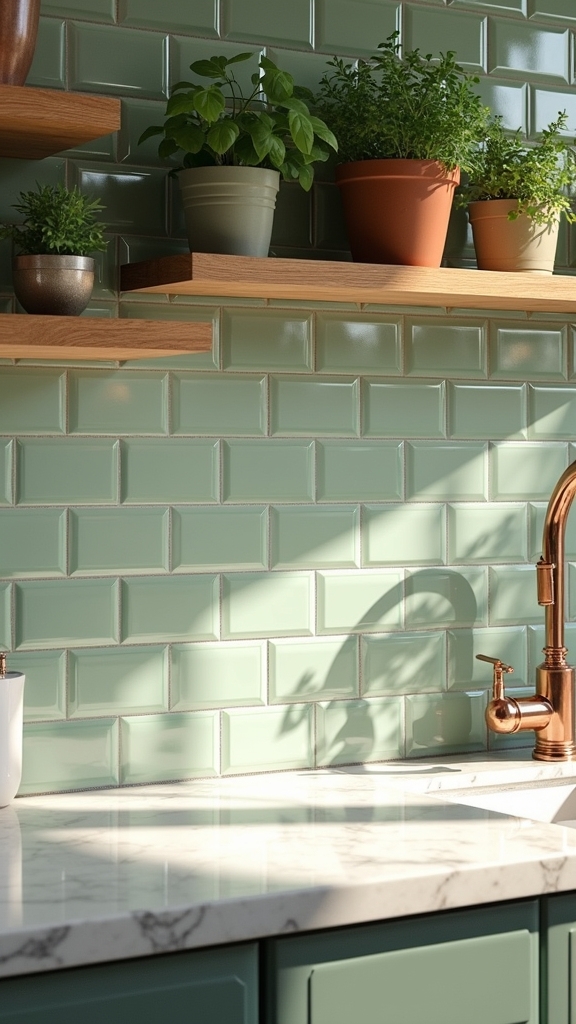
A sophisticated green-on-green approach emerges by layering sage tile tones, allowing subtle gradients to enrich the backsplash’s visual depth.
Designers often weigh the impact of glossy versus matte finishes, each offering distinct light interplay and tactile quality.
Patterned sage tile options further heighten the design narrative, introducing geometric or artisanal motifs for a refined, cohesive effect.
Layered Sage Tile Tones
By layering sage tile tones across a kitchen backsplash, designers achieve a refined green-on-green palette that evokes tranquility and a connection to nature.
This approach employs a harmonious range of sage hues—soft olive, muted eucalyptus, and deeper forest—strategically arranged to deliver visual interest without overwhelming the space.
The integration of textured sage tiles, such as handcrafted or zellige varieties, introduces a tactile dimension that enhances the backsplash beyond mere color, enhancing depth and sophistication.
Carefully selected layered sage tile tones form a cohesive color palette, complementing cabinetry and providing a continuous, natural feel.
When extended to the ceiling, the backsplash draws the eye upward, expanding the sense of space and creating a seamless, immersive environment with organic undertones.
Glossy Versus Matte Finishes
When determining the ideal finish for a sage tile backsplash, the interplay between glossy and matte surfaces becomes a pivotal element in defining the kitchen’s ambiance. Glossy finishes on sage tiles amplify natural light, imparting a sense of spaciousness while intensifying color vibrancy and pattern visibility.
In contrast, matte finishes offer a refined, muted aesthetic, cultivating a tranquil, welcoming environment. The strategic integration of both finishes enhances visual interest and introduces a layered, contemporary look.
Key considerations include:
- Glossy finishes reflect light, expanding perceived space and brightness.
- Matte finishes embody understated elegance, ideal for cozy, intimate settings.
- Green-on-green sage tiles evoke harmonious, nature-inspired design continuity.
- Combining both finishes allows for accentuation and creative contrast within the backsplash.
Lighting, space, and desired aesthetic should guide finish selection.
Patterned Sage Tile Options
Countless patterned sage tile options transform kitchen backsplashes into visually engaging focal points, balancing modern sophistication with the inherent tranquility of green-on-green palettes.
Herringbone and chevron patterned tiles introduce dynamic movement, while intricate mosaic arrangements in sage tones provide both texture and a sense of bespoke craftsmanship.
Mixing glossy and matte finishes among backsplash tiles amplifies visual interest, creating nuanced interplay with light and shadow, especially when paired with coordinating sage cabinetry.
Extending sage tile backsplashes to the ceiling enhances spatial perception, contributing to a seamless, cohesive design that unifies all kitchen elements.
Altogether, these approaches foster a nature-inspired atmosphere, utilizing the versatility of sage tones to harmonize with surrounding décor and boost the kitchen’s aesthetic with a sophisticated, calming sensibility.
Marble Slab Backsplash for a Luxe Touch

Elevating a kitchen’s aesthetic, a marble slab backsplash introduces a sense of luxury and timeless elegance, especially when paired with sage green cabinetry.
This pairing creates a sophisticated palette where the cool veining of marble complements the soft, earthy tones of sage green cabinets. The integration of brass fixtures enhances the luxurious element, producing a cohesive look that feels both modern and inviting.
Marble’s inherent durability guarantees longevity and practicality within kitchen design.
Marble’s natural strength ensures your kitchen remains both beautiful and functional for years to come.
- Contrast and Harmony: The striking contrast between marble slab backsplash and sage green cabinets amplifies visual interest.
- Material Versatility: Options such as polished or honed finishes allow for tailored ambiance control.
- Durability: Marble withstands heat and moisture, essential for culinary spaces.
- Elevated Detailing: Brass fixtures introduce warmth, completing a balanced, high-end aesthetic.
Terrazzo Patterns to Add Playful Texture
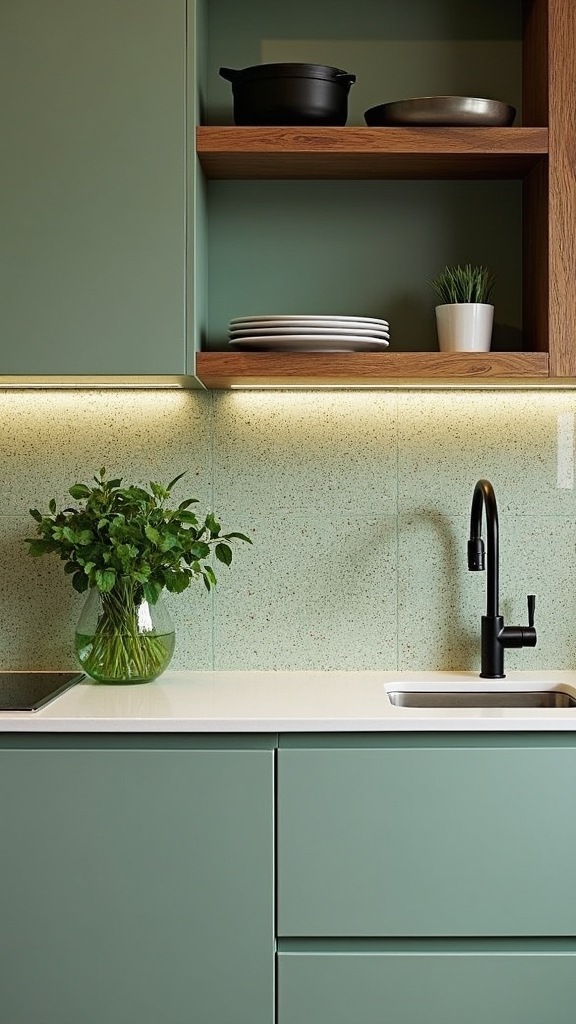
How does one infuse a kitchen with both modern flair and tactile intrigue? Terrazzo backsplashes present a compelling answer, merging composite materials—marble, granite, quartz, and glass chips—into a surface rich in playful texture and visual interest.
In a sage green kitchen, terrazzo patterns can be expertly customized to mirror the cabinetry’s tones, forging a cohesive aesthetic that feels both curated and dynamic. The interplay of vibrant, multicolored chips against soothing sage green elements introduces a modern twist, while terrazzo’s renowned durability guarantees longevity and effortless maintenance.
Pattern scale ranges from delicate speckling to bold, graphic aggregates, allowing for tailored expression within contemporary or eclectic design schemes. Ultimately, terrazzo’s unique textural interplay enhances the sage green kitchen, balancing classic harmony with trend-forward appeal.
Mosaic Tiles for Visual Interest
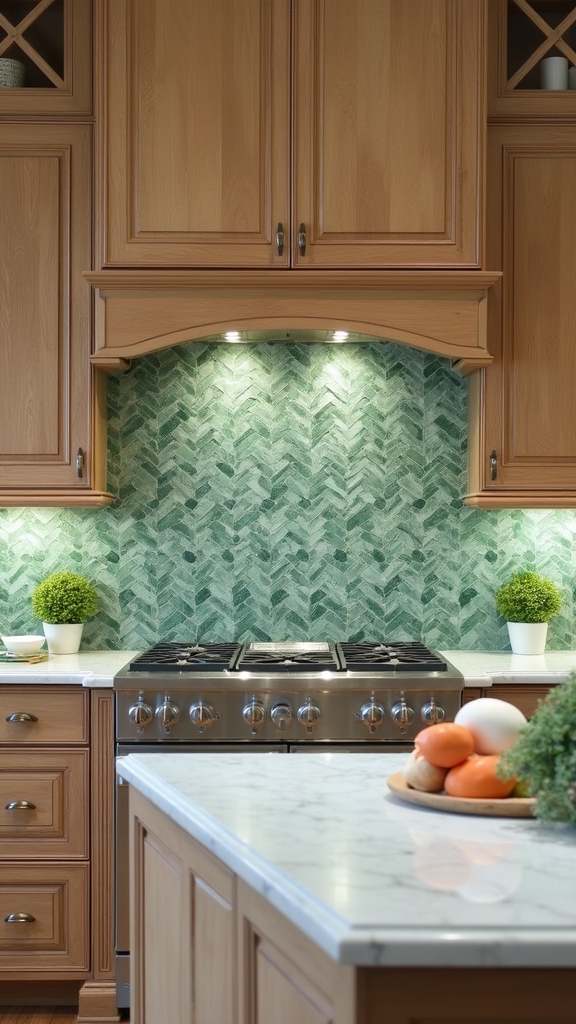
While terrazzo patterns introduce playful texture, mosaic tiles offer another dimension of visual intrigue for a sage green kitchen.
Mosaic tiles serve as a sophisticated decorative element, seamlessly complementing sage green cabinetry and fostering a cohesive kitchen environment. Their adaptability in material—ranging from glass to ceramic and stone—allows for tailored finishes that reflect personal style.
Mosaic tiles elegantly enhance sage green cabinetry, offering versatile materials and finishes that express individual style in any kitchen space.
For those seeking to maximize visual interest and enhance brightness, consider these strategic applications:
- Select intricate herringbone or chevron mosaic layouts to impart depth and character.
- Opt for glass mosaic tiles to reflect more light, thereby enhancing openness.
- Incorporate color blends that echo sage green and adjacent elements for harmony.
- Pair mosaic tiles with wood or brass accents to unify the kitchen’s aesthetic narrative.
Each approach guarantees a visually compelling, balanced space. The color psychology of green evokes calmness and sophistication, further enhancing the serene environment created by these design elements.
Vertical Stacked Satin White Tiles

With their crisp geometry and lustrous finish, vertical stacked satin white tiles establish a strikingly modern backsplash that effortlessly enhances sage green cabinetry.
The vertical orientation draws the eye upward, imparting visual height and creating an illusion of expanded space—an invaluable asset in compact kitchens.
The satin surface subtly reflects natural light, amplifying brightness and highlighting the cabinetry’s muted green undertones.
This sophisticated tile choice coordinates seamlessly with a variety of countertop materials, from the organic warmth of butcher block to the sleek resilience of quartz, ensuring cohesive visual flow.
In addition to their aesthetic merit, vertical stacked satin white tiles are easy to clean, resisting stains and humidity typical of culinary environments.
The result is a harmonious balance of form, function, and contemporary appeal.
Dramatic Glazed Black Subway Tiles
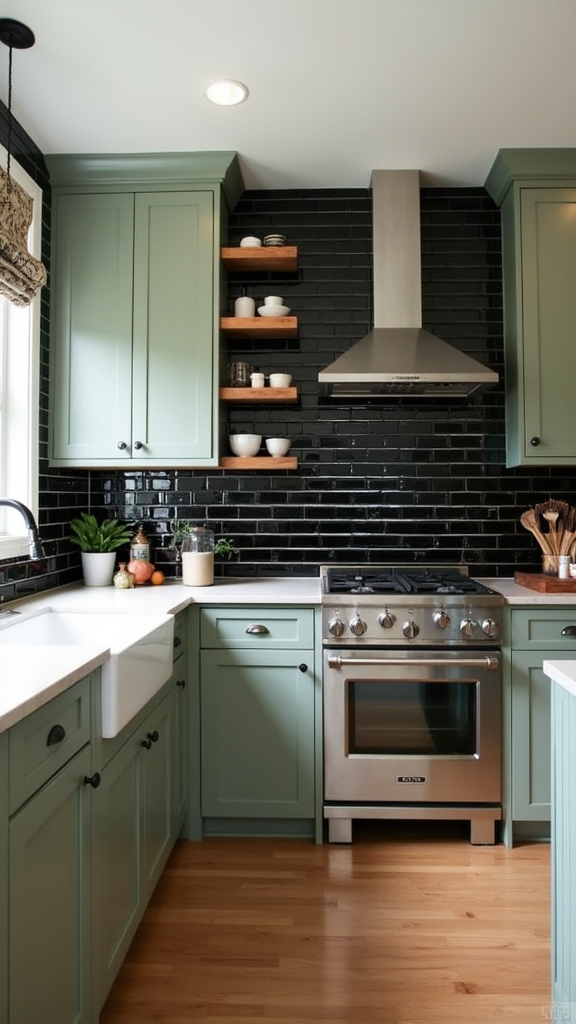
A bold interplay of contrast and sheen defines the impact of dramatic glazed black subway tiles in kitchen design. When installed against sage green cabinets, these tiles maximize visual appeal through a sophisticated juxtaposition of color and finish. Their glossy surface not only reflects ambient light but also delivers depth and dimension, making even compact kitchens feel expansive and luminous. The following aspects exemplify their effect:
- Contrast Enhancement: The black tiles sharply delineate sage green cabinetry, amplifying color vibrancy.
- Material Practicality: Their glazed finish guarantees durability and easy maintenance, ideal for busy kitchens.
- Pattern Versatility: Arrangements such as herringbone or staggered offer unique texture and character.
- Elegant Pairings: Brass accents and natural wood elements complete a cohesive, modern kitchen aesthetic.
This synergy blends practicality with design innovation. Additionally, incorporating gold hardware can add a touch of luxury, complementing the overall aesthetics and enhancing the visual appeal of the space.
Patterned Ceramic Tiles for Personality
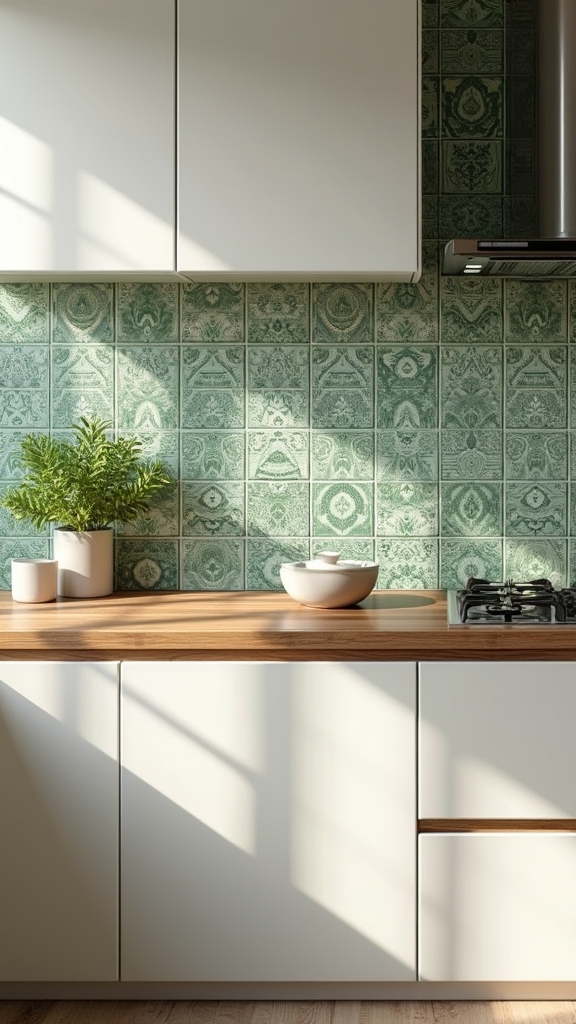
Infusing a backsplash with patterned ceramic tiles introduces immediate visual intrigue and individuality to a sage green kitchen. These tiles, available in motifs such as herringbone or chevron, enhance the kitchen design by adding visual interest and depth without overwhelming the subtle sophistication of sage green cabinetry.
The versatility of patterned ceramic tiles enables homeowners to achieve a cohesive look, whether by echoing the tones of the cabinetry or opting for a contrasting palette to create a dynamic focal point. Texture and layered patterns draw the eye, transforming the backsplash into an intentional highlight that unifies other design elements within the space.
Additionally, the practicality of patterned ceramic tiles—easy to clean and maintain—makes them a functional yet stylish choice for daily kitchen environments.
Wooden Accents Paired With Sage Backsplash
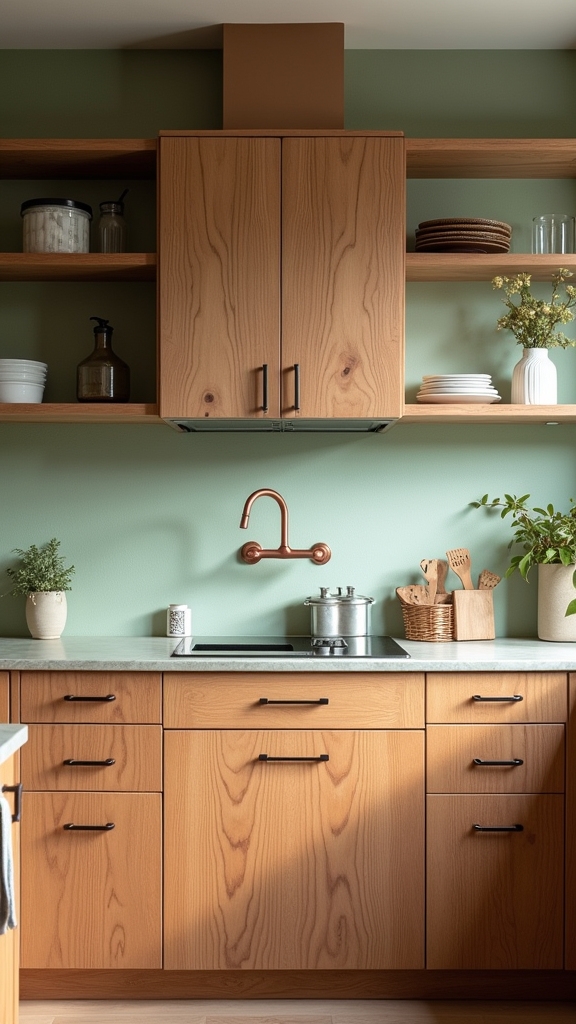
Pairing sage green backsplashes with wooden accents introduces a nuanced interplay of warmth and texture, anchoring the space in natural elegance.
The juxtaposition of soft green tiles with oak or walnut surfaces cultivates a balanced tone, allowing the backsplash to command attention while supporting a unified palette.
This synthesis of materials achieves a refined modern rustic appeal, ideal for homeowners seeking both visual comfort and stylistic cohesion.
Enhancing Warmth With Wood
Wooden accents introduce a natural warmth and tactile depth that beautifully offsets the cool undertones of a sage green backsplash.
The interplay between wood accents and sage green cultivates a harmonious, cohesive kitchen that feels both grounded and inviting.
Expert designers often highlight these strategies for achieving a visually striking yet balanced kitchen space:
- Opt for butcher block countertops to infuse earthy tones and organic texture alongside a sage green backsplash.
- Incorporate light oak or walnut finishes in cabinetry to amplify warmth while maintaining modern elegance.
- Use reclaimed wood shelving to add rustic charm and reinforce eco-friendly design principles.
- Pair sage green with wood-accented furniture for a seamless blend of comfort and sophistication.
This synthesis of sage green and wood enhances kitchen aesthetics, imbuing timeless appeal and natural serenity.
Balancing Texture and Tone
A kitchen’s visual harmony is achieved by thoughtfully balancing the soft, muted undertones of a sage green backsplash with the tactile richness of wood. Sage green tiles introduce a subtle color palette that is both calming and sophisticated, acting as an ideal backdrop for wooden accents.
Integrating natural materials such as light oak or rich walnut cabinetry deepens the sense of depth and texture, enhancing the overall cohesiveness of the space. The interplay between matte sage tiles and glossy wooden surfaces generates visual interest, allowing each element to assert its presence without overpowering the other.
This strategic combination not only highlights the beauty of eco-friendly finishes but also aligns with contemporary design principles, yielding a kitchen environment that feels both uplifted and inviting through precise balance.
Modern Rustic Appeal
When sage green backsplash tiles are juxtaposed with wooden accents, the result is a kitchen that seamlessly bridges modern refinement and rustic comfort.
This harmonious interplay of natural textures underscores the appeal of modern rustic aesthetics while preserving a cohesive design language. The sage green backsplash, paired with elements such as reclaimed wood shelves or butcher block countertops, evokes a farmhouse-style ambiance—warm, inviting, and grounded.
Earthy tones in sage green complement a spectrum of wood finishes, from pale oak to rich walnut, enabling versatile and visually unified layouts.
- Opt for a patterned sage green backsplash (herringbone or subway) to introduce subtle visual interest.
- Combine reclaimed wooden accents for authentic rustic texture.
- Employ butcher block countertops to foster a seamless modern-rustic conversion.
- Coordinate wood and sage hues for cohesive, layered warmth.
Full-Height Backsplash for Seamless Design
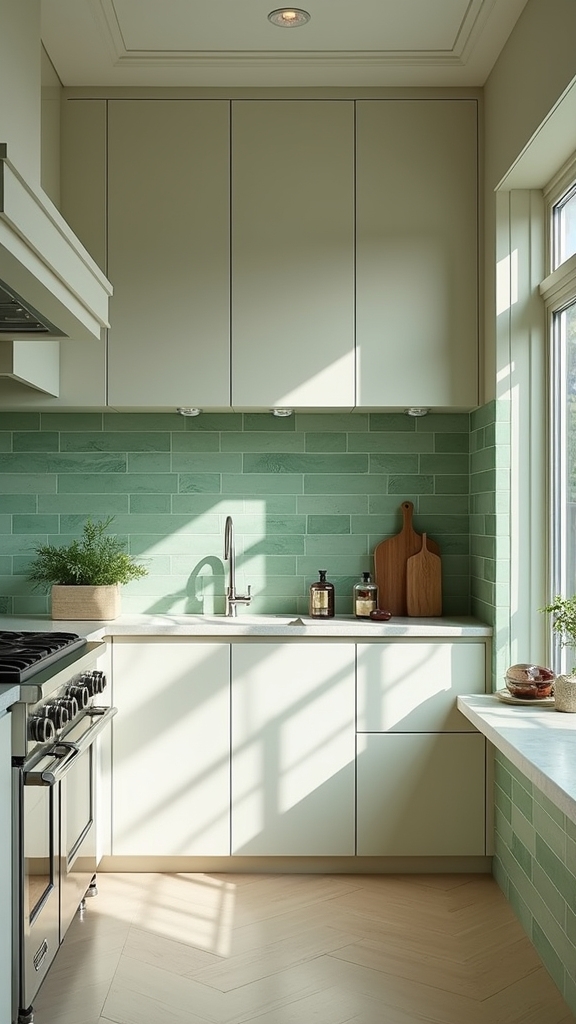
Countless modern kitchens benefit from the integration of a full-height backsplash, a design feature that extends seamlessly from the countertop to the upper cabinets or ceiling.
This approach fosters a cohesive look, particularly when paired with sage green cabinetry, by minimizing visual interruptions and amplifying the sense of spatial continuity.
The full-height backsplash not only enhances the visual impact with uninterrupted expanses of color or pattern but also streamlines the kitchen’s overall aesthetic.
Material selection—whether tile, stone, or quartz—offers flexibility while ensuring harmony with the cabinetry’s sage hue.
From a practical perspective, the reduction of seams and grout lines results in easier cleaning and maintenance, making this design both functional and visually compelling.
The result is a unified, sophisticated kitchen environment.
Brass Sheet Backsplash for Warmth and Elegance
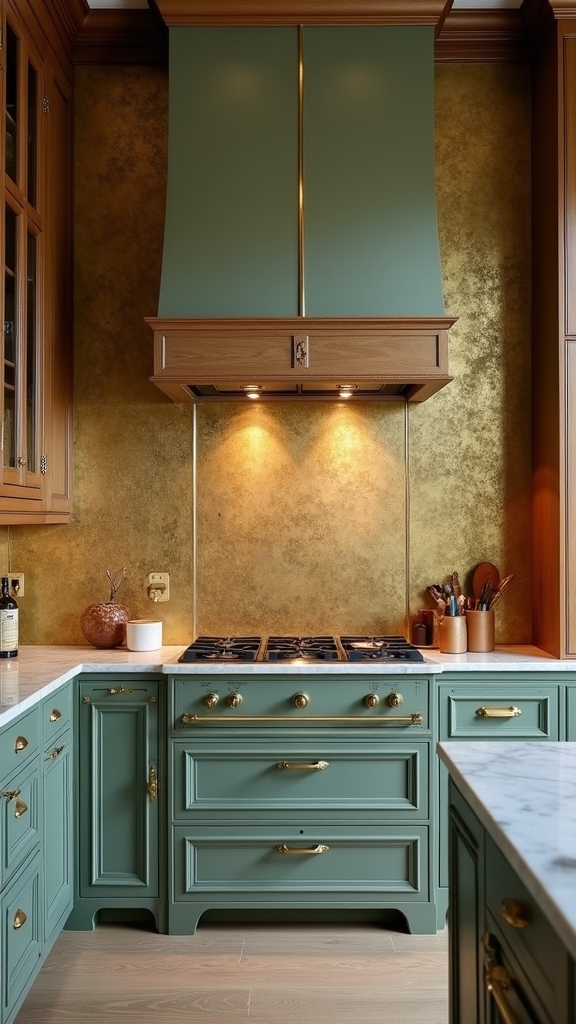
Introducing a brass sheet backsplash infuses sage green kitchens with a distinct layer of warmth and refined elegance, establishing a sophisticated interplay between metallic luster and muted cabinetry.
The reflective surface of brass enhances ambient light, accentuating the calming qualities of sage while amplifying spatial brightness. For those seeking both aesthetic and practical benefits, consider the following:
- The seamless finish of a brass sheet backsplash delivers a modern touch that complements cabinetry and uplifts the kitchen’s overall tone.
- Integrating brass hardware—such as handles or faucets—with the backsplash guarantees a cohesive design language throughout the space.
- Brass’s low-maintenance attributes make it ideal for busy kitchens, requiring only gentle cleaning to retain its sheen.
- Pairing brass with wood or marble enriches texture, depth, and visual interest within sage green kitchens.
Window Backsplash to Maximize Natural Light
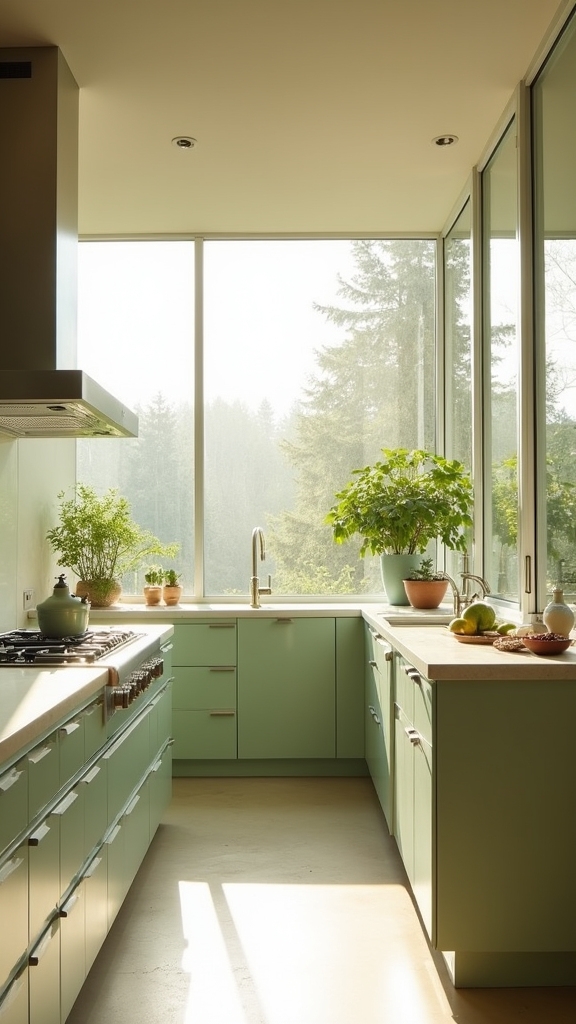
A window backsplash introduces a luminous architectural element, optimizing daylight penetration and visually expanding the kitchen environment.
Glass installations in this application not only amplify natural illumination but also establish a seamless visual connection to exterior surroundings, harmonizing indoor and outdoor aesthetics.
This approach is particularly effective in accentuating color palettes such as sage green, resulting in a cohesive and vibrant design narrative.
Enhancing Daylight With Glass
Illumination takes center stage when a glass window backsplash is integrated into kitchen design, channeling abundant natural light to enhance both spatial perception and ambiance.
This design approach is particularly impactful when paired with sage green cabinetry, as the reflective properties of glass amplify the soft, organic hues, fostering an inviting atmosphere.
The interplay between glass and natural light not only optimizes the kitchen’s brightness but also accentuates the calming qualities of sage green, creating a cohesive visual experience.
Key benefits include:
- Amplifies daylight, making compact kitchens feel spacious.
- Reflects and diffuses light, minimizing harsh shadows.
- Showcases outdoor elements, harmonizing with sage green tones.
- Guarantees easy maintenance, preserving a pristine, luminous aesthetic.
The result is a kitchen where daylight and design coalesce seamlessly.
Seamless Indoor-Outdoor Connection
When a kitchen incorporates a window backsplash, the boundary between interior and exterior dissolves, establishing a seamless indoor-outdoor connection that transforms both space and atmosphere.
This architectural element introduces abundant natural light, amplifying the airy quality of sage green cabinetry while providing a visual extension to the outdoor scenery. The reflective surface of large glass panels not only enhances spatial perception but also mirrors surrounding greenery, reinforcing the calming, earthy tones integral to the design.
Strategically positioned, a window backsplash becomes a striking focal point, drawing the eye outdoors and integrating the kitchen with nature. Incorporating plants or fresh herbs along the sill further accentuates this synergy, harmonizing the tactile warmth of sage green with the organic vibrancy visible just beyond the glass.
Moroccan-Inspired Tiles for Artistic Flair
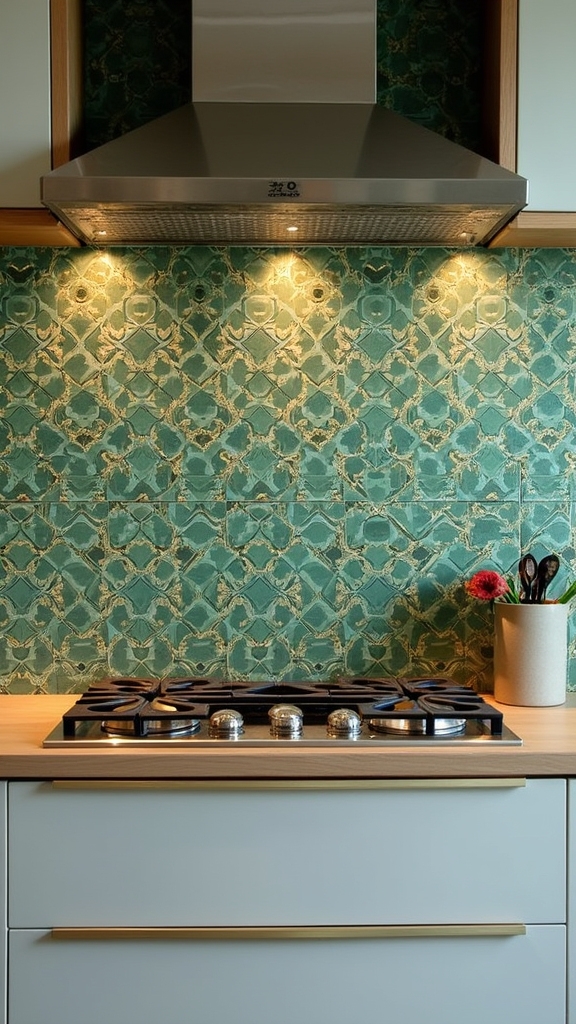
Moroccan-inspired tiles, distinguished by their intricate geometric motifs and vivid color palettes, introduce a sophisticated layer of artistry to sage green kitchens. As a backsplash, these tiles serve as a dynamic focal point, elevating the soft, calming tones of sage cabinetry with both texture and depth. The interplay between Moroccan-inspired tiles and a sage green kitchen offers a unique artistic flair that resonates across design eras. Their adaptability enables seamless integration within both modern and traditional styles, making them a compelling choice for those seeking to enhance visual interest. Dynamic contrast: Bold patterns complement the gentle hue of sage green cabinetry. Texture and depth: Handmade zellige or ceramic tiles enrich tactile and visual quality. Artistic expression: Geometric motifs infuse personality and cultural resonance. Versatile context: Harmonizes beautifully in contemporary or classic kitchen environments. Incorporating floating shelves can further enhance the kitchen’s aesthetic by maximizing counter space while showcasing decorative pieces.
Quartz Backsplash for Sleek Simplicity
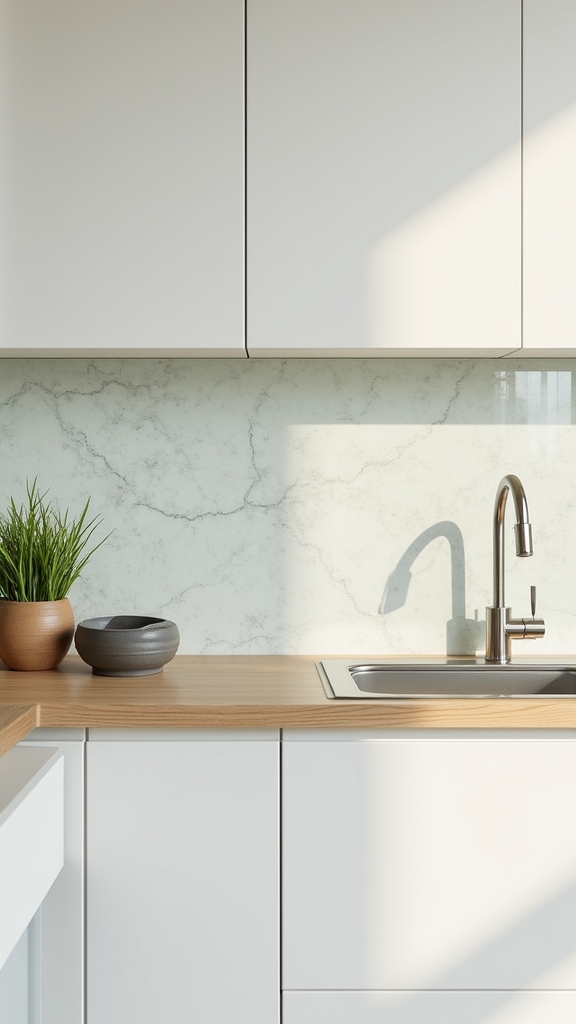
While many backsplash options add visual interest through color or pattern, a quartz backsplash distinguishes itself by imparting a seamless, refined surface that amplifies the modern sophistication of a sage green kitchen.
Engineered for precision, quartz backsplashes can be expertly matched with quartz countertops, guaranteeing a cohesive look that visually expands the space. The non-porous surface guarantees low maintenance, resisting stains and moisture for longevity in high-traffic kitchen environments.
Quartz’s ability to mimic natural stone—such as marble or granite—delivers a luxurious yet practical alternative, eliminating the upkeep traditionally associated with genuine stone.
The light-reflective properties of quartz further enhance an airy feel, making the backsplash complete the kitchen’s unified aesthetic. This approach supports both functional durability and a visually harmonious design.
Frequently Asked Questions
What Backsplash Goes With Sage Cabinets?
Selecting a backsplash for sage cabinet styles involves considering complementary tile options, color theory basics, and texture combinations. Metallic accents or vintage patterns introduce visual contrast, while cohesive design is achieved through thoughtful interplay of hues, finishes, and materiality.
What Is the Trend in Kitchen Backsplash 2025?
In 2025, kitchen backsplash trends highlight sustainable materials, bold patterns, and metallic finishes. Designers emphasize textured surfaces and geometric designs, integrating striking color contrasts to achieve a visually dynamic, eco-conscious, and cohesively sophisticated backdrop for contemporary culinary spaces.
Should Your Backsplash Be Lighter or Darker Than a Countertop?
Determining whether a backsplash should be lighter or darker than the countertop depends on desired color contrast, visual balance, and design cohesion. Material choice influences light reflection, while lighter tones enhance space perception and darker tones provide dramatic, grounded aesthetics.
What Kind of Backsplash Makes a Kitchen Look Bigger?
To create the illusion of a larger kitchen, designers recommend a backsplash featuring light colors, reflective surfaces, and vertical tiles. These elements amplify light, enhance visual depth, and support a minimalist design, fostering an open concept and cohesive aesthetic.
Conclusion
A sage kitchen backsplash offers endless opportunities to harmonize form and function. Whether opting for classic subway tiles, luxurious marble, or artistic Moroccan patterns, each backsplash selection creates a visual anchor that enhances the overall design. Subtle green tones complement a spectrum of materials, from brass to terrazzo, fostering a cohesive and sophisticated ambiance. By thoughtfully integrating sage elements, homeowners achieve a balanced interplay of color, texture, and light—seamlessly unifying the kitchen’s aesthetic narrative.
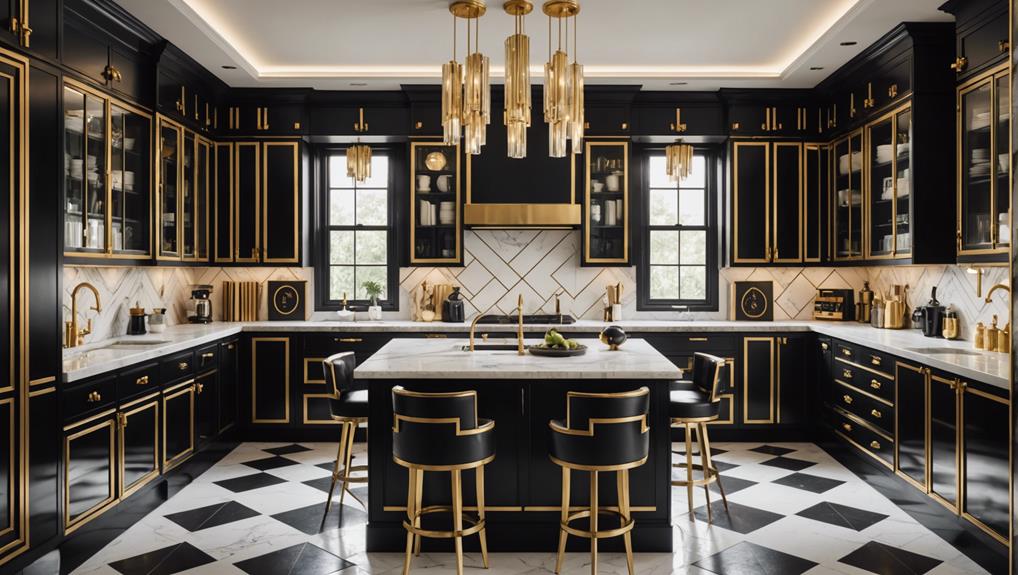

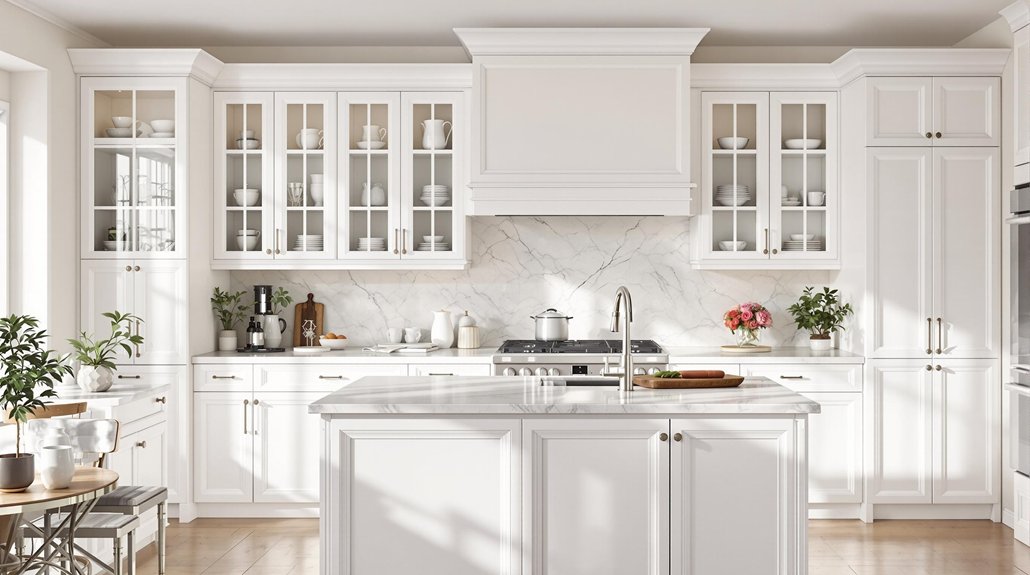
Leave a Reply